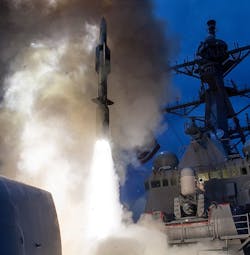Raytheon moves to full-scale development of upgraded terminal-homing SM-2 Block IIIC shipboard missile
Officials of the U.S. Naval Sea Systems Command in Washington announced a $149.4 million contract Friday to the Raytheon Missile Systems segment in Tucson, Ariz., for engineering and manufacturing development (EMD) of the SM-2 Block IIIC.
This missile is an active terminal-homing version of the SM-2 medium-range missile. It adds the active-homing radar seeker of the SM-6 Extended Range Active Missile (ERAM) to the existing SM-2 airframe, which has inertial and command mid-course guidance.
EMD is where a system is developed and designed before going into production, and is to complete system development, develop affordable and efficient manufacturing processes, complete system fabrication, and test and evaluate the system before proceeding into full production.
The SM-2 Block IIIC guidance system, which comes from the SM-6 ERAM, was developed originally for the Raytheon aircraft-launched AIM-120 AMRAAM -- one of the nation's most sophisticated radar-guided air-to-air missiles, and one of the world's most advanced all-weather, all-environment, medium-range air-to-air missiles for engaging enemy aircraft and missiles from beyond visual ranges.
Currently Raytheon is working on for phase 4b Form, Fit, Function Refresh (F3R) of the AMRAAM guidance section to extend the missile's lifetime well into the 2020s. AMRAAM is standard armament on the F/A-18E/F Super Hornet, Eurofighter Typhoon, F-22, F-35, F-16, F-15E, and other combat jets.
Blending active radar homing and the SM-2 missile airframe gives the missile added capability against agile maneuvering targets, as well as against targets beyond the effective range of the launching vessel's target-illumination radar.
The Raytheon SM-2 Block IIIC is aboard Navy Ticonderoga-class cruisers and Arleigh Burke-class destroyers. It deploys from the Mk 41 Vertical Launch System (VLS). It is designed for use against fixed-wing aircraft, helicopters, unmanned aerial vehicles, and anti-ship cruise missiles. It also can be used as a high speed anti-ship missile.
On this contract Raytheon will do the work in Tucson, Ariz; Wolverhampton, England; East Aurora, N.Y.; Middletown, Ohio; and Englewood, Colo., and should be finished by October 2022.
For more information contact Raytheon Missile Systems online at www.raytheon.com, or Naval Sea Systems Command at www.navsea.navy.mil.
Ready to make a purchase? Search the Military & Aerospace Electronics Buyer's Guide for companies, new products, press releases, and videos

